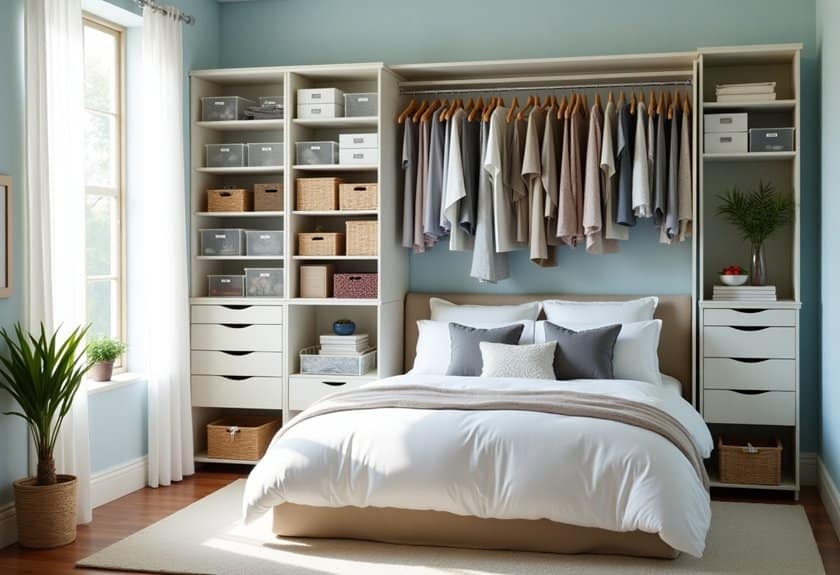Ever noticed how a well-organized bedroom can transform your entire mood? I’ve discovered that the right storage solutions and smart layouts can turn even the smallest space into a peaceful sanctuary. Whether you’re dealing with a cramped apartment or just wanting to refresh your master suite, these 12 bedroom organization ideas will help you maximize every square inch. Let’s explore how you can create that magazine-worthy setup you’ve been dreaming about!
Under-Bed Storage Solutions That Maximize Space
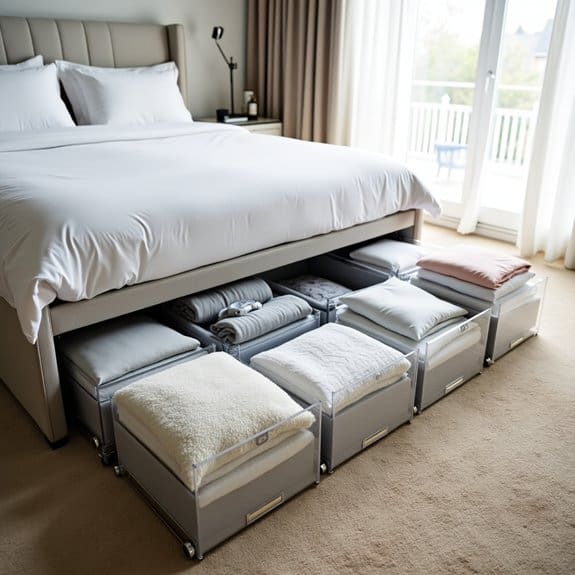
Making use of under-bed space is one of the most effective ways to maximize storage in any bedroom, regardless of its size. This often-overlooked area can provide valuable square footage for storing seasonal items, extra bedding, clothing, and other essentials that don’t require daily access.
Proper under-bed storage organization not only helps declutter your living space but also protects items from dust and extends their lifespan. When implemented correctly, this storage solution can eliminate the need for additional furniture pieces, creating a more spacious and serene bedroom environment.
Required Items:
- Under-bed storage containers or drawers
- Storage bags with zipper closures
- Bed risers (if needed)
- Measuring tape
- Labels and marker
- Vacuum bags (for clothing/bedding)
- Anti-dust covers
- Drawer dividers
- Clear plastic bins
- Wheels or casters (optional)
Start by measuring the available space under your bed, including height, width, and depth. Clear out the area completely and vacuum thoroughly. Select storage containers that maximize the measured space while allowing for easy sliding in and out.
If additional height is needed, install bed risers to create extra storage capacity. Sort items into categories based on frequency of use and season. Place frequently accessed items toward the front of the bed for easy reach. Use vacuum storage bags for bulky items like winter clothing or extra bedding to compress them and save space.
Label all containers clearly on multiple sides for easy identification. For optimal organization, implement a rotation system where seasonal items are stored at the back during their off-season and moved forward when needed.
Consider installing wheels on storage containers for smoother access, and use drawer dividers within larger containers to maintain organization of smaller items. Always leave a small gap between containers for air circulation and easier removal.
Additional Tips:
Position heavier items closer to the bed frame’s support points to prevent sagging. Use clear containers when possible to easily identify contents without pulling everything out.
Create a detailed inventory list of stored items and their locations, and review contents every six months to prevent forgotten items from accumulating. Consider using moisture absorbers in containers storing fabric items to prevent musty odors and maintain freshness.
Vertical Wall Storage and Floating Shelves
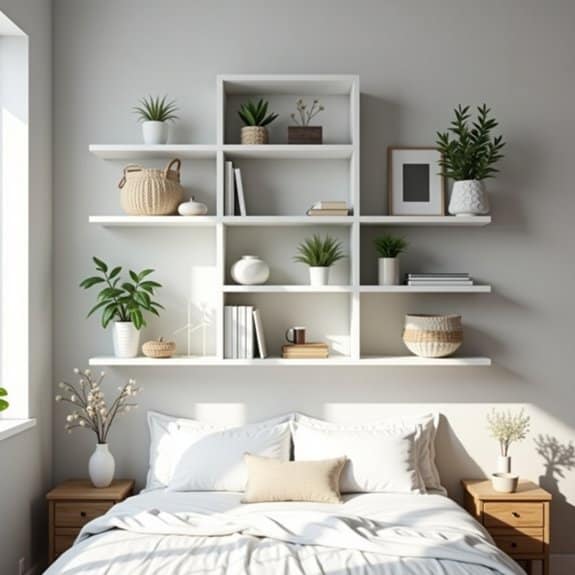
Making the most of vertical wall space is essential in any bedroom, particularly in smaller spaces where floor space is at a premium. Vertical storage solutions and floating shelves not only maximize storage capacity but also create an aesthetically pleasing display that can showcase personal items while keeping them organized and easily accessible.
By implementing vertical storage solutions, you transform unused wall space into functional storage areas that can house everything from books and decorative items to daily essentials. This approach helps maintain a clutter-free floor space while adding architectural interest to your bedroom’s design.
Required Items:
- Stud finder
- Level
- Drill and drill bits
- Screwdriver
- Wall anchors
- Floating shelves
- Mounting brackets
- Measuring tape
- Pencil
- Storage bins or baskets
- Command hooks or wall hooks
- Wall-mounted organizers
Start by surveying your wall space and marking potential locations for shelves and organizers using a pencil and level. Use a stud finder to locate wall studs, which will provide the most secure mounting points. Install the largest items first, such as floating shelves, ensuring they’re perfectly level and properly anchored to the wall.
Space shelves at practical intervals, considering the height of items you plan to store. For areas between shelves, add complementary storage solutions such as wall-mounted hooks, pegboards, or wire baskets. Group similar items together on shelves and in organizers, maintaining clear zones for different categories: decorative items on higher shelves, frequently used items at eye level, and heavier items on lower shelves.
When arranging items on your new vertical storage system, maintain breathing room between objects and avoid overcrowding. Rotate seasonal items to keep the system functional and fresh throughout the year. Consider using coordinating storage containers or baskets to create a cohesive look while hiding smaller items that might otherwise appear cluttered.
Smart Closet Organization Systems
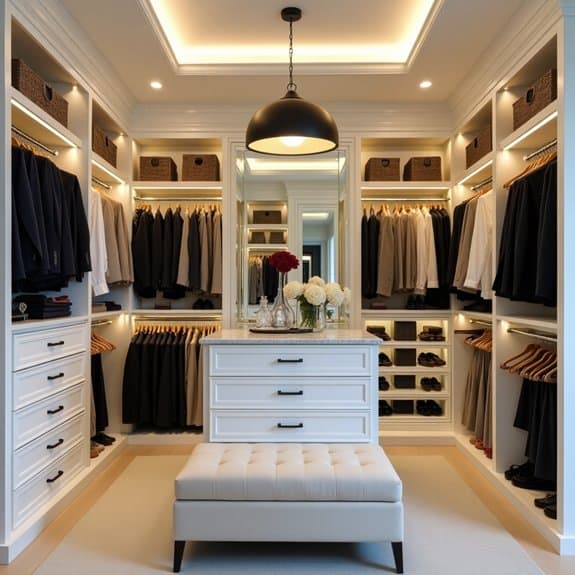
A well-organized closet serves as the foundation for an efficient morning routine and a clutter-free bedroom. When closet space is optimized with smart organization systems, it becomes easier to locate items, maintain order, and maximize available storage space, ultimately reducing stress and saving valuable time.
Installing a smart closet organization system transforms a basic storage space into a functional, customized solution that adapts to your specific needs. These systems can double your usable space while creating designated areas for different types of clothing, accessories, and personal items, making it simpler to maintain organization long-term.
Required Items:
- Closet rod organizers
- Drawer units
- Shelf dividers
- Hanging organizers
- Clear storage boxes
- Label maker
- Clothing hangers (uniform style)
- Belt/tie/scarf organizers
- Shoe racks
- Storage baskets
- Measuring tape
- Level
- Basic tools (screwdriver, drill)
Start by removing everything from your closet and measuring the space thoroughly, including height, width, and depth. Install the main components of your organization system, beginning with vertical elements like drawer units and shelving.
Position adjustable rods at appropriate heights – upper rods for shirts and jackets, lower rods for pants and dresses. Add specialized organizers for accessories, ensuring frequently used items are easily accessible.
Group similar items together, using clear storage boxes for seasonal items and storage baskets for smaller pieces. Implement a double-hang system where possible to maximize vertical space, and install shoe racks at the bottom of the closet.
Utilize door-mounted organizers for additional storage of accessories or small items. Position drawer units strategically to store folded clothes and create natural divisions within the space.
Additional Tips: Consider implementing a color-coding system or using uniform hangers to maintain visual consistency. Install motion-sensor lighting to improve visibility, and leave some empty space for future additions.
Review and adjust your organization system every few months to ensure it continues to meet your needs, and maintain a “one-in-one-out” rule to prevent overcrowding.
Streamlined Nightstand Arrangements
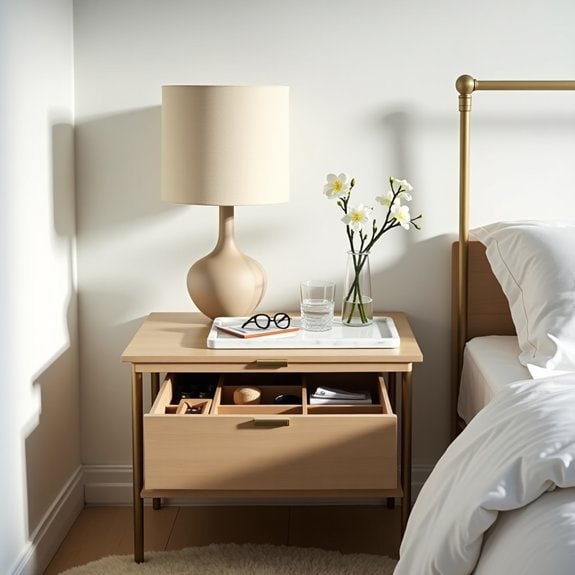
A well-organized nightstand is essential for creating a peaceful bedroom environment and ensuring easy access to nighttime necessities. The bedside table often becomes a catch-all space for various items, leading to clutter and frustration when trying to locate important things in the dark or during early morning hours.
An efficiently arranged nightstand not only improves the aesthetic appeal of your bedroom but also contributes to better sleep hygiene by reducing visual chaos and maintaining essential items within arm’s reach. The key is to create a functional system that works for your specific needs while maintaining a clean, uncluttered surface.
Required Items:
- Small drawer organizers or dividers
- Decorative tray
- Reading lamp
- Charging station or cord organizer
- Small trash bin
- Drawer liner
- Storage boxes or baskets
- Disinfecting wipes
- Microfiber cloth
Start by removing everything from your nightstand and wiping down all surfaces. Sort items into three categories: daily essentials, occasional use, and items that belong elsewhere.
Install drawer organizers to create designated spaces for smaller items like medications, reading glasses, or personal care products. Place frequently used items on top of the nightstand, arranged neatly on a decorative tray to contain them and create a cohesive look.
Position your reading lamp at the back corner of the nightstand, ensuring proper illumination without taking up too much space. Establish a charging station for electronic devices, using cord organizers to prevent cable tangles. Store occasional-use items in the drawer, organized by frequency of use, with the most accessed items toward the front.
Additional Tips: Consider implementing a regular weekly maintenance routine to prevent clutter accumulation. Keep a small trash bin nearby to dispose of unnecessary items promptly. Use the “one in, one out” rule when adding new items to your nightstand arrangement.
Finally, evaluate your nightstand contents seasonally, removing items that haven’t been used in the past three months to maintain optimal organization.
Multi-Purpose Furniture for Small Bedrooms
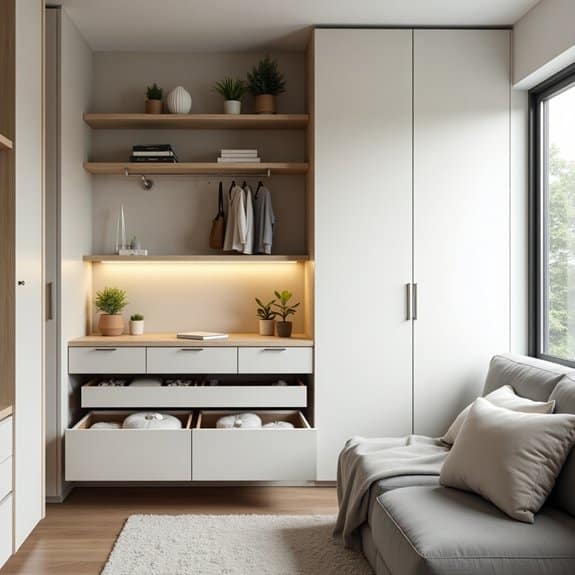
Making the most of limited bedroom space requires strategic planning and innovative furniture solutions. Multi-purpose furniture serves as a cornerstone of small bedroom organization, allowing residents to maximize every square foot while maintaining functionality and style.
In small bedrooms, each piece of furniture must work twice as hard to justify its footprint. Multi-purpose furniture not only saves space but also reduces clutter, eliminates the need for additional storage pieces, and creates a more streamlined, efficient living environment.
Required Items:
- Measuring tape
- Floor plan or sketch of room
- List of storage needs
- Basic tools (screwdriver, level)
- Furniture sliders
- Storage containers
- Labels
- Notebook for planning
Implementing multi-purpose furniture starts with assessing your specific needs and available space. Begin by measuring your room’s dimensions and identifying prime locations for dual-function pieces.
Consider a platform bed with built-in drawers for clothing storage, or select a headboard with integrated shelving for books and decorative items. Position a storage ottoman at the foot of the bed to serve as both seating and extra storage space.
Install a wall-mounted desk that folds down when needed and disappears when not in use. Replace traditional nightstands with floating shelves or small wall-mounted cabinets that can hold both decorative items and practical necessities.
For clothing storage, opt for a wardrobe system with a built-in vanity or desk area, maximizing vertical space while providing multiple functions in one unit.
Final Tips: When selecting multi-purpose furniture, prioritize pieces that serve your most frequent needs first. Choose items with smooth, easy-to-use mechanisms to ensure long-term functionality.
Keep the color scheme consistent and opt for furniture with clean lines to prevent the space from feeling cluttered. Regularly assess the effectiveness of each piece and be willing to make adjustments as your needs change.
Drawer Dividers and Storage Containers
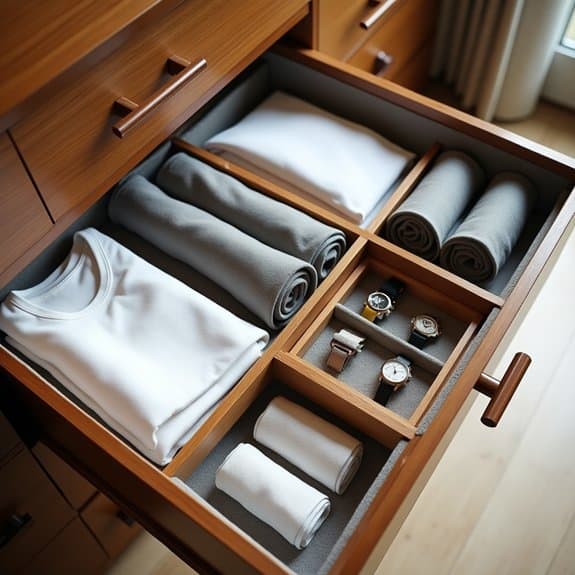
Drawer Dividers and Storage Containers
—
Having organized drawers is essential for maintaining an orderly bedroom and streamlining daily routines. When belongings are properly compartmentalized, finding specific items becomes effortless, saving valuable time during busy mornings and preventing frustration from rummaging through messy drawers.
Drawer dividers and storage containers transform chaotic spaces into well-structured systems, allowing you to maximize every inch of drawer space while keeping items visible and accessible. This organization method works particularly well for clothing, accessories, and personal items, ensuring they stay neat and protected from damage.
Required Items:
- Drawer dividers (adjustable or fixed)
- Small storage containers or boxes
- Drawer liner material
- Measuring tape
- Labels or label maker
- Scissors
- Storage bins (various sizes)
- Drawer organizer trays
Start by completely emptying the drawer and measuring its dimensions. Install drawer liners to protect the surface and prevent items from sliding.
Group similar items together and assess which divider or container combinations will work best for each category. For clothing drawers, use expandable dividers to create sections for different garment types. For accessories and smaller items, implement small containers or organizer trays that fit within the drawer’s measurements.
Position the larger dividers first, creating main sections within the drawer. Place smaller containers within these sections as needed. Arrange items by frequency of use, keeping regularly accessed items toward the front. Roll clothing items when possible to maximize visibility and prevent wrinkles.
Store accessories and small items in dedicated containers to prevent tangling or loss. Consider implementing a rotation system for seasonal items and regularly reassess the organization system’s effectiveness.
Label containers clearly to maintain order and establish a habit of returning items to their designated spots immediately after use. For maximum longevity, choose sturdy dividers and containers that can withstand frequent use while maintaining their shape and position within the drawer.
Seasonal Clothing Rotation Strategies

Managing seasonal clothing effectively is crucial for maintaining an organized and clutter-free bedroom. When clothes for all seasons compete for limited closet space, it becomes difficult to find what you need and keep your wardrobe organized. A well-planned seasonal rotation system helps maximize storage space while protecting off-season clothing from damage.
Implementing a seasonal clothing rotation strategy not only creates more breathing room in your closet but also provides an opportunity to assess your wardrobe twice yearly. This process allows you to evaluate items for wear and tear, donate unused pieces, and ensure your clothing collection remains current and functional for your lifestyle.
Required Items:
- Storage containers or vacuum bags
- Cedar blocks or lavender sachets
- Labels and marker
- Clothing rack
- Clean sheets or garment bags
- Plastic bins
- Inventory list
- Storage space (attic, basement, or under-bed)
Start by removing all clothing from your closet and sorting items into three categories: current season, next season, and storage. Clean all garments thoroughly before storage, ensuring they’re completely dry to prevent mildew.
Fold heavy sweaters and knits to maintain their shape, and hang structured pieces like coats and suits in garment bags. Use vacuum storage bags for bulky items like winter coats and bedding to maximize space.
Pack clothes in clear containers or labeled boxes, grouping similar items together. Add cedar blocks or lavender sachets to naturally repel moths and maintain freshness. Store containers in a cool, dry place away from direct sunlight and potential water damage.
Create an inventory list of stored items and their locations to easily locate specific pieces when needed.
For optimal results, perform seasonal rotations during transitional weather periods, typically spring and fall. Keep a small selection of versatile pieces from the opposite season accessible for unexpected weather changes.
Regularly inspect stored clothing for any signs of damage or pest activity, and consider using dehumidifiers in storage areas to maintain ideal conditions. Remember to clean storage containers before reusing them for the next rotation cycle.
Behind-the-Door Storage Innovations
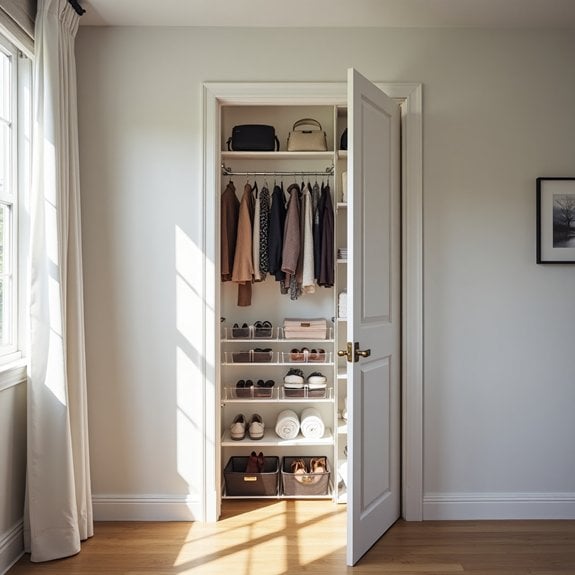
Making use of the often-overlooked space behind your bedroom door can transform your storage capabilities and maximize every square inch of your room. This vertical space presents endless possibilities for organizing everything from shoes and accessories to daily essentials, helping to keep floor space clear and maintain a clutter-free environment.
Behind-the-door storage solutions provide convenient access while keeping items hidden when the door is open, creating a clean aesthetic in your bedroom. This organizing method is particularly valuable for small spaces and rental properties where permanent storage solutions aren’t possible.
Required Items:
- Over-the-door hanging organizer
- Command hooks or mounting hardware
- Measuring tape
- Level
- Door-mounted rack system
- Storage baskets or bins
- Clear storage pockets
- Door bumpers
- Screwdriver
- Pencil
Start by measuring your door’s dimensions and the available space when the door is both open and closed. Install door bumpers to prevent damage to walls and ensure proper clearance.
Select an over-the-door organizing system that suits your specific storage needs – consider combinations of hooks, shelves, and pockets. Mount the system securely, ensuring it’s level and properly anchored.
For shoes and accessories, arrange items with frequently used pieces at eye level. Utilize clear pockets for smaller items like socks, jewelry, or beauty products. Install additional hooks at various heights for items like scarves, belts, or bags. If using a shelf system, arrange storage bins or baskets by category, labeling each for easy identification.
Additional Tips:
To maintain organization and prevent door strain, regularly assess the weight distribution and avoid overloading the system. Clean behind the door weekly to prevent dust accumulation, and periodically check mounting hardware for security.
Consider using shower curtain rings on hooks to create additional hanging options, and rotate seasonal items to maintain relevant, easy access to currently needed items.
Decluttering Your Bedside Space
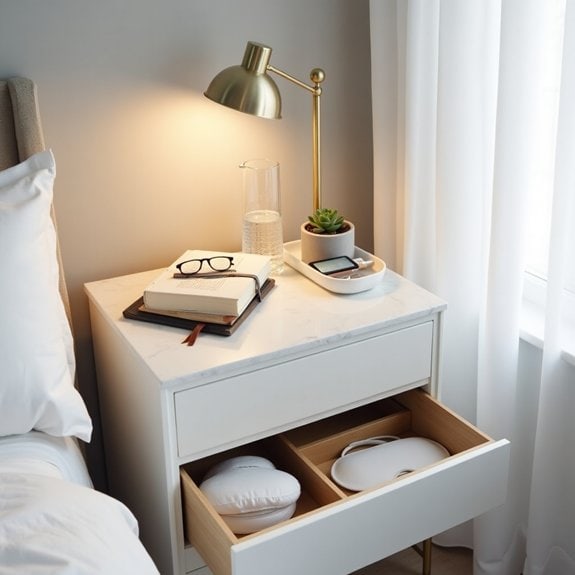
A well-organized bedside area serves as the foundation for both peaceful evenings and productive mornings. This intimate space is often the last thing we see before sleep and the first thing we encounter upon waking, making it crucial for setting the tone of our daily routine and maintaining a sense of calm in our bedroom sanctuary.
An overcrowded nightstand not only creates visual chaos but can also interfere with essential functions like reaching for water, checking the time, or finding important items in the dark. By streamlining this space, you’ll eliminate stress-inducing clutter and create an efficient system that supports both practical needs and relaxation.
Required Items:
- Small drawer organizers or dividers
- Storage container for cables
- Bedside lamp
- Basic cleaning supplies
- Small trash bag
- Storage box for overflow items
- Multi-port charging station
- Small tray for daily essentials
Start by removing everything from your bedside table and wiping down all surfaces. Sort items into three categories: daily essentials, occasional use, and items that belong elsewhere. Keep only frequently used items within arm’s reach, limiting them to necessities like reading glasses, current book, water bottle, and phone charger.
Install a compact charging station to manage electronic devices and eliminate cable clutter. Create designated zones within drawers using organizers, maintaining separate sections for personal care items, medications, and entertainment materials. Position your lamp to provide adequate lighting while maximizing available surface space.
Consider mounting floating shelves above the nightstand if additional storage is needed for books or decorative items.
Additional Tips: Establish a weekly maintenance routine to prevent clutter from accumulating. Keep a small catch-all dish for temporary items, but empty it daily. Consider implementing a “one in, one out” rule for bedside items, and rotate reading materials regularly to prevent stockpiling.
Position essential items closest to the bed’s edge for easy access, and store seasonal or rarely used items in another location.
Minimalist Wardrobe Organization
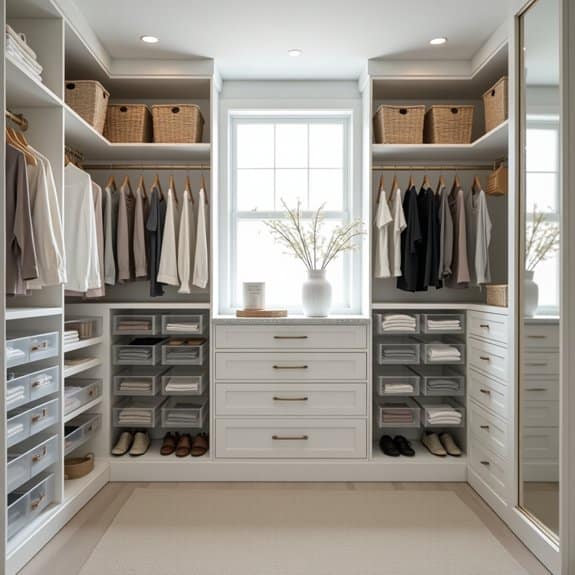
A well-organized minimalist wardrobe transforms your daily routine by eliminating decision fatigue and creating a sense of calm in your bedroom space. When every item has its designated place and serves a clear purpose, getting dressed becomes effortless, and maintaining order becomes second nature.
The minimalist approach to wardrobe organization focuses on quality over quantity, ensuring that each piece in your collection coordinates well with others and truly reflects your lifestyle needs. This system not only saves time but also maximizes your available space and helps you develop a more intentional relationship with your belongings.
Required Items:
- Clothing hangers (uniform style)
- Drawer dividers
- Storage boxes
- Clothing folding board
- Labels
- Garment bags
- Shelf dividers
- Storage baskets
- Donation bags
Start by removing everything from your wardrobe and sorting items into three categories: keep, donate, and discard. For items you’re keeping, create subcategories based on type (tops, bottoms, dresses) and season. Arrange hanging clothes by category and color, using matching hangers to maintain visual consistency.
Fold remaining items using the vertical folding method, placing them in drawers with dividers to maintain organization. Store seasonal items in clearly labeled storage boxes, and protect special occasion pieces in garment bags.
The key to maintaining a minimalist wardrobe lies in implementing the one-in-one-out rule and conducting regular assessments of your clothing collection. Position frequently worn items at eye level and in easily accessible locations. Create a capsule wardrobe within your existing collection by selecting versatile pieces that can be mixed and matched.
Ensure proper spacing between hangers to prevent clothing damage and maintain visibility of all items. To ensure long-term success, conduct monthly mini-reviews of your wardrobe organization system, adjusting as needed.
Install good lighting to better see your clothing options, and consider taking photos of favorite outfit combinations for quick reference. Keep a small donation bag in your closet for immediately removing items that no longer serve you, and resist the urge to fill empty spaces with new purchases simply because they exist.
Creative Storage for Accessories and Jewelry
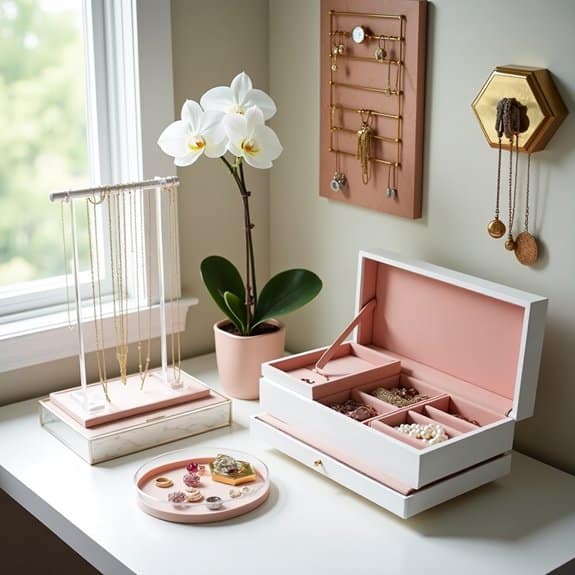
Organizing accessories and jewelry is crucial for protecting valuable pieces while ensuring easy access to your favorite items. A well-organized jewelry and accessory collection prevents tangling, damage, and frustration when getting ready, ultimately saving time during your daily routine.
Creating designated spaces for different types of accessories not only preserves their condition but also helps you inventory what you own, preventing unnecessary duplicate purchases and allowing you to rotate through your collection more effectively. Proper organization can transform your accessories from a jumbled mess into an attractive display that enhances your bedroom’s aesthetic.
Required Items:
- Jewelry organizer or stand
- Small fabric-lined boxes
- Drawer dividers
- Clear plastic containers
- Hooks or pegboard
- Hanging organizers
- Soft pouches
- Ring holders
- Watch box
- Microfiber cloths
Start by sorting all accessories and jewelry into categories: necklaces, bracelets, rings, watches, scarves, and other accessories. Assess each piece’s frequency of use and value to determine the most appropriate storage solution.
Install wall-mounted organizers or dedicated hooks for frequently worn pieces, keeping them visible and easily accessible. Use drawer organizers with designated compartments for smaller items like rings and earrings, placing soft fabric at the bottom of each section to prevent scratches.
For delicate necklaces, hang them individually on hooks or specialty organizers to prevent tangling. Store special occasion pieces in fabric-lined boxes or soft pouches to protect them from dust and oxidation.
Utilize vertical space by mounting mirrors with hidden storage or installing floating shelves for decorative storage boxes that double as display pieces.
Additional Success Tips: Maintain your organization system by returning items to their designated spots immediately after use. Consider storing seasonal accessories in separate containers during off-seasons to reduce clutter.
Clean jewelry regularly and inspect storage areas monthly for signs of tarnish or damage. Position your storage solutions near good lighting to make selection and organization easier during your daily routine.
Hidden Storage Solutions for Small Spaces
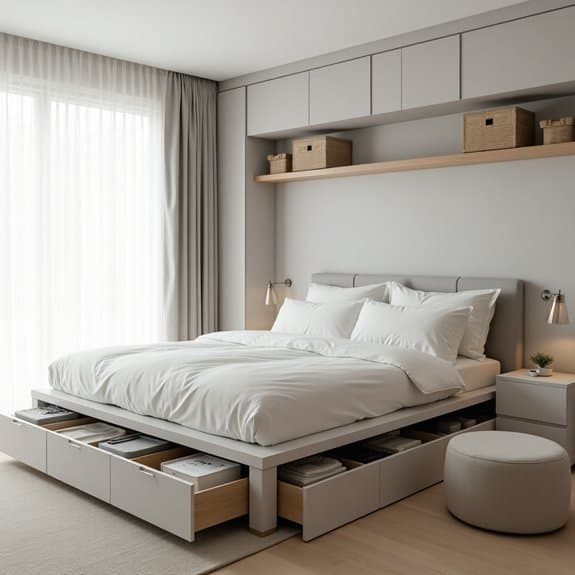
Making the most of limited bedroom space requires creative thinking and strategic planning. Hidden storage solutions can transform a cramped bedroom into a functional, organized sanctuary by utilizing otherwise wasted space and keeping essential items out of sight but within easy reach.
Small bedrooms present unique challenges, but implementing hidden storage solutions can effectively double your available space while maintaining a clean, uncluttered aesthetic. These clever storage options take advantage of vertical space, unused corners, and furniture that serves multiple purposes.
Essential Items:
- Under-bed storage containers
- Over-door hanging organizers
- Bed risers
- Space-saving hangers
- Storage ottomans
- Drawer organizers
- Command hooks
- Storage baskets
- Vacuum storage bags
- Multi-purpose furniture
Start by evaluating your bedroom’s layout and identifying potential hidden storage areas. Install bed risers to create additional under-bed storage space, then use flat storage containers designed specifically for under-bed use.
Maximize vertical space by installing floating shelves in unused corners and over doorways. Replace traditional furniture with storage-equipped alternatives, such as beds with built-in drawers or nightstands with hidden compartments.
For clothing storage, implement a rotation system using vacuum storage bags for out-of-season items, storing them under the bed or in high closet spaces. Utilize the back of doors with over-door organizers for shoes, accessories, or additional clothing storage.
Install hooks on the sides of furniture or in closets for hanging bags, scarves, or belts.
Additional Tips: Consider furniture arrangement carefully to create hidden nooks for storage, and label all containers clearly for easy access. Regularly assess stored items to prevent accumulation of unnecessary belongings, and maintain a designated space for frequently used items within arm’s reach.
Remember to measure all spaces accurately before purchasing storage solutions to ensure proper fit and maximum efficiency.

